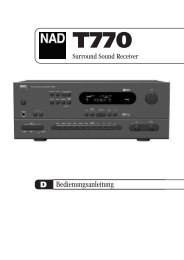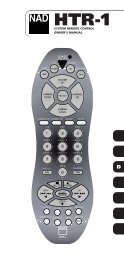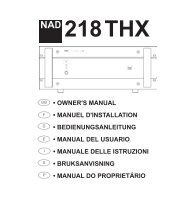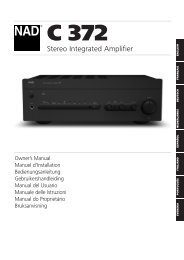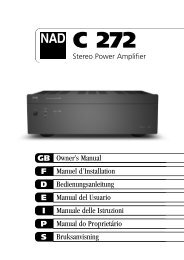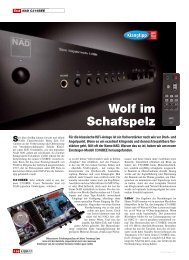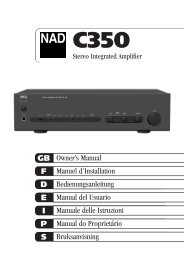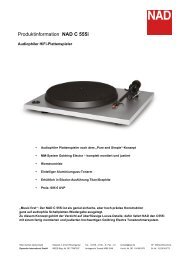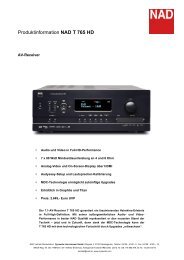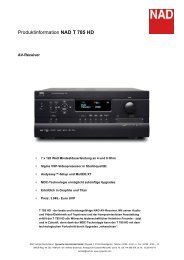C 352 - NAD
C 352 - NAD
C 352 - NAD
You also want an ePaper? Increase the reach of your titles
YUMPU automatically turns print PDFs into web optimized ePapers that Google loves.
ENGLISH FRANÇAIS DEUTSCH ESPAÑOL ITALIANO PORTUGUÊS SVENSKA<br />
2. POWER / STAND-BY / PROTECTION INDICATOR<br />
Upon switching Power on, the indicator will light up amber in standby<br />
state. While one of the input select buttons is pressed, the LED will turn<br />
red for a moment, then turn green for ON state. In cases of serious<br />
abuse of the amplifier, such as overheating, excessively low loudspeaker<br />
impedance, short circuit, etc. the amplifier will engage its Protection<br />
circuitry, the indicator will light up red and the sound will be muted. In<br />
such a case, turn the amplifier off, wait for it to cool down and/or check<br />
the speaker connections, making sure the overall loudspeaker<br />
impedance doesn’t go below 4 ohms. Once the cause for the protection<br />
circuitry to engage has been removed, switch the amplifier On again.<br />
The diagram below shows the operation of the Stand-by / protection<br />
indicator:<br />
Green Amber Red<br />
Normal Operation •<br />
Stand-by •<br />
Protection •<br />
3. HEADPHONE SOCKET<br />
A 1/4” stereo jack socket is supplied for headphone listening and will<br />
work with conventional headphones of any impedance. Inserting a<br />
headphone jack into this socket automatically switches off the<br />
loudspeakers. The volume, tone and balance controls are operative for<br />
headphone listening. Use a suitable adapter to connect headphones<br />
with other types of sockets, such as 3.5mm stereo ‘personal stereo’<br />
jack plugs.<br />
NOTE: Make certain that the volume control is turned to minimum (fully<br />
counter-clockwise) before connecting or disconnecting headphones.<br />
Listening at high levels can damage your hearing.<br />
4. INFRA-RED REMOTE CONTROL COMMAND RECEIVER<br />
The infrared sensor, located behind this circular window, receives<br />
commands from the remote control. There must be a clear line-of-sight<br />
path from the remote control to this window; if that path is obstructed,<br />
the remote control may not work.<br />
NOTES: When a command from the remote control is received, the<br />
Stand-by/protection indicator will blink. Note that the indicator may also<br />
blink when receiving commands not necessarily for the C <strong>352</strong> but for<br />
other components in the system.<br />
Direct sunlight, very bright or fluorescent ambient lighting may affect<br />
the operating range and angle for the remote control handset.<br />
6<br />
5. INPUT SELECTORS<br />
These buttons select the active input to the <strong>NAD</strong> C <strong>352</strong> and the signal<br />
sent to the loudspeakers, the Tape outputs and the Pre-Out sockets. The<br />
buttons on the remote control handset duplicate these buttons, with<br />
the exception of the tuner input; see below. Green indicators just above<br />
each button show which input is currently selected.<br />
DISC Selects a line-level source connected to the DISC sockets as the<br />
active input.<br />
CD Selects the CD (or other line-level source) connected to the CD<br />
sockets, as the active input.<br />
VIDEO Selects the VCR (or stereo TV/Satellite/Cable receiver) connected<br />
to the VIDEO sockets, as the active input.<br />
AUX Selects a line-level source connected to the AUX sockets, as the<br />
active input.<br />
TUNER Selects the tuner (or other line-level source) connected to the<br />
Tuner sockets, as the active input.<br />
TAPE 2 Selects Tape 2 as the active input.<br />
TAPE 1 Monitor Selects the output from a tape recorder when playing<br />
back tapes or monitoring recordings being made through the Tape 1<br />
sockets. Press the Tape 1 button once to select it and again to return to<br />
the normal input selection.<br />
Tape 1 is a tape Monitor function which does not override the current<br />
input selection. For example, if the CD is the active input when TAPE 1<br />
is selected, then the CD signal will continue to be selected and sent to<br />
both the TAPE 2, and TAPE 1 OUTPUT sockets, but it is the sound from<br />
recorder connected to Tape 1 that will be heard on the loudspeakers.<br />
Apart from the amber indicator to show Tape 1 is engaged, the green<br />
indicator for the active input will also stay lit.<br />
NOTE: The remote control handset with the C <strong>352</strong> supplied is of a<br />
universal <strong>NAD</strong> type, designed to operate several <strong>NAD</strong> models. Some<br />
buttons on this handset are inoperative as the functions aren't<br />
supported by the C <strong>352</strong>. The Video 2 and Video 3 input selector buttons<br />
on the remote control handset are inoperative in the case of the C <strong>352</strong>.<br />
6. SOFT CLIPPING INDICATOR<br />
The green SOFT CLIPPING indicator shows that the Soft Clipping<br />
mode is engaged. Refer also to chapter "Rear Panel Connections",<br />
section 12; "Soft Clipping" for more information.<br />
7. BASS & TREBLE CONTROLS<br />
The <strong>NAD</strong> C <strong>352</strong> is fitted with BASS and TREBLE tone controls to adjust<br />
the tonal balance of your system. The 12 o’clock position is ‘flat’ with<br />
no boost or cut and a detent indicates this position. Rotate the control<br />
clockwise to increase the amount of Bass or Treble. Rotate the control<br />
anti-clockwise to decrease the amount of Bass or Treble. The Tone<br />
controls do not affect recordings made using the Tape outputs but will<br />
affect the signal going to the Pre-amp output (Pre Out).<br />
8. TONE DEFEAT<br />
The TONE DEFEAT switch bypasses the tone control section of the <strong>NAD</strong><br />
C <strong>352</strong>. If the Tone Controls are not normally used and left in the 12<br />
o'clock position, then it is advisable to switch out the Tone Control<br />
section altogether by using this switch. In the 'out' position, the Tone<br />
Control circuits are active, pushing the TONE DEFEAT switch 'in'<br />
bypasses the Tone Control section.



